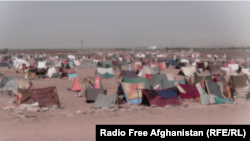Farmer Abdul Qayoom is among thousands of Afghans who are newly displaced.
It wasn’t the fighting, though, that forced him leave his home in western Afghanistan.
Instead, he is seeking shelter from a devastating drought that has ruined his livelihood.
A prolonged lack of rain and dissipating groundwater destroyed his fields and killed his livestock, prompting Qayoom to move with his wife and their eight children to the western city of Herat from their village in neighboring Badghis Province.
Speaking with Radio Free Afghanistan from his temporary home in Dasht-e Shaidayee on the outskirts of Herat, he described how the drought disrupted their lives and eventually forced them to leave their village, Sharshar.
“We were forced to leave because there was no water. All wells and the springs dried up,” he said. “We could not farm our lands because of the lack of rain. I had cows and sheep, but they died because there was no grass or pasture.”
When the cattle began to die, the price per cow dropped from $1,400 to just under $300, and it was difficult to find a buyer for a sheep for under $30.
Qayoom is one of the 5,000 families that local authorities say have sought refuge in Herat during the past month. All fled their villages in the nearby provinces of Badghis, Ghor, and Faryab.
Just recently a UN office warned that this year’s drought has affected Afghanistan’s 20 provinces including Badghis, Uruzgan, and Jawzjan.
In its report released in May, the United Nations Office for the Coordination of Humanitarian Assistance (UNOCHA) said that “this drought will have a particularly detrimental effect on already chronically food insecure farming households.”
UNOCHA estimates that out of approximately 2.2 million people affected by the drought, at least 1.4 million will become acutely food insecure. They will require emergency assistance over the coming months and into the next lean season, the report said.
“We are concerned that the poorest cohort of Afghan society, particularly those already displaced by conflict, will be worst affected,” said Christopher Nyamandi, the Norwegian Refugee Council’s (NRC) country director in Afghanistan.
“Displaced people affected by the drought are prevented from reaching markets and aid due to the ongoing armed conflict,” he added.
Photo Gallery: Severe Drought Grips Afghanistan
A survey conducted by the NRC in January found that “one in two displaced Afghans said they could not adequately feed their families and were often skipping meals.” This figure is an increase from one in three six years ago.
A June 4 statement by the NRC noted that regional differences are stark. “One in four respondents in conflict-affected [southern] Kandahar and [eastern] Nangarhar provinces say they had suffered hunger over the past year, compared with one in six in Kabul,” it said.
Janan Kochi is a nomad and a livestock herder in Charchino district of southern Uruzgan Province. Speaking with Radio Free Afghanistan, he said nomads have been devastated by this year's drought.
“The Kochis have been affected very badly,” he said. “We spent the winter and spring without rain. There is no grass in the mountains nor in the desserts.”
In northern Jawzjan Province, residents have similar concerns.
Shukrullah, 50, a local farmer, has been recently displaced from the Qush-Teppa district. He now lives in a rundown house in the provincial capital, Sheberghan, together with his wife and their five daughters.
“We planted some 700 kilograms of wheat seeds, but our crop was destroyed by a lack of rain,” he said. “I lost my cows, sheep, and chickens, as well, which prompted me to move to the city.”
Najib Aqa Fahim, head of the Afghanistan National Disaster Management Authority, says his country is experiencing the peak of a drought.
“Thirteen million Afghans in 20 provinces [out of a total 34] are affected by drought,” he told journalists on June 3. “Out of these, 1 million people and 3 million livestock are in urgent need of food and water.”
Earlier, the Afghan Agriculture and Livestock Ministry said it is working on a $100 million plan to help the drought-stricken communities during the next two months.
Despite these pledges, Qayoom says his family has received little assistance.
“All I need is food and a shelter to live my life. I just don’t want to die from hunger and the hot weather,” he said.







